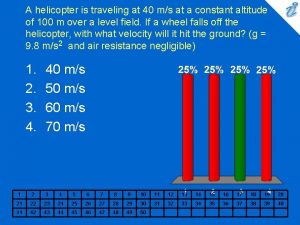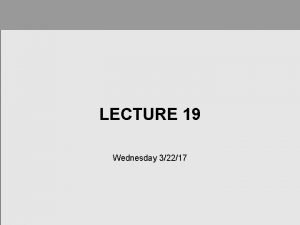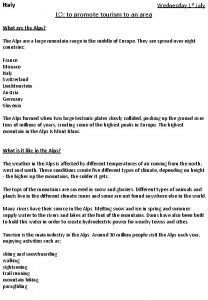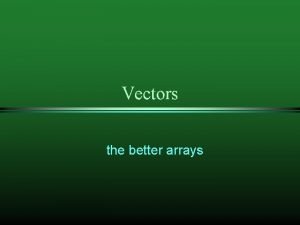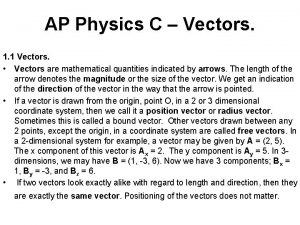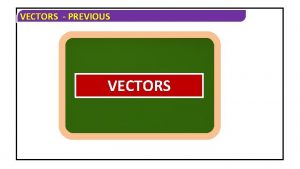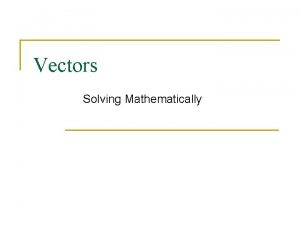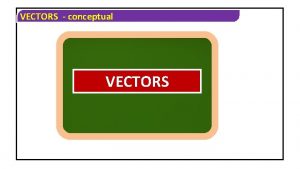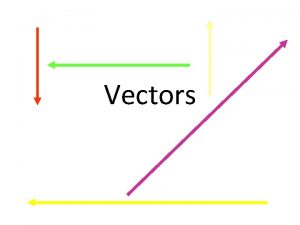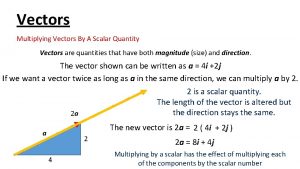MATH 200 WEEK 1 WEDNESDAY VECTORS MATH 200





















- Slides: 21

MATH 200 WEEK 1 - WEDNESDAY VECTORS

MATH 200 MAIN QUESTIONS FOR TODAY ▸ What is a vector? ▸ What operations can we do with vectors? ▸ What kinds of representations and notations do we have for vectors? ▸ What are some of the important properties of vectors?

MATH 200 DEFINITION ▸ A vector is a mathematical object with magnitude and direction. ▸ Representation: arrow whose length corresponds to magnitude ▸ Notation: ▸ Bold letters - e. g. v as opposed to v ▸ Arrow over letter:

MATH 200 SUMS OF VECTORS ▸ We add two vectors by putting them tail-to-end and then drawing the resultant vector from start to finish. ▸ E. g. , say we want to add two vectors v and w, shown below.

MATH 200 ¡¡IMPORTANT!! THESE ARE ALL THE SAME BECAUSE THEY HAVE THE SAME DIRECTION AND MAGNITUDE ▸ VECTORS DO NOT HAVE FIXED POSITION!

MATH 200 SCALAR MULTIPLES OF VECTORS ▸ A scalar is a quantity with only magnitude (no direction) ▸ By multiplying a vector by a scalar, we can ▸ Scale its length/magnitude ▸ Change its direction if the scalar is negative

MATH 200 DIFFERENCES OF VECTORS ▸ With scalars, we can think of subtraction as addition of negative numbers. ▸ E. g. , 5 - 2 = 5 + (-2) = 3 ▸ The same goes for vectors: v - w = v + (-w)

MATH 200 VECTORS IN RECTANGULAR COORDINATES ▸ Suppose I draw a vector from one point to another. Call these points P 1(x 1, y 1, z 1) and P 2(x 2, y 2, z 2) P 2 ▸ We’ll write this vector in the following way: P 1

MATH 200 STANDARD POSITION ▸ When we draw a vector with its tail at the origin, we’ll say it’s in standard position. ▸ For a vector in standard position, the terminal point gives the components directly… So if this is the point (2, 5, 2), then the vector is…

MATH 200 A 2 D EXAMPLE ▸ Do the following: ▸ Draw and label x and y axes ▸ Pick two vectors (e. g. v = <1, 2> and w = <-3, 1>) ▸ Draw v with its tail at the origin ▸ Draw w with its tail at the terminal point of v ▸ Draw v + w

MATH 200 <3, 1> <1+3, 2+1> = <4, 3> <1, 2>

MATH 200 PROPERTIES Vector operations work pretty much the way we’d like!

MATH 200 PARALLEL VECTORS ▸ We saw that scalar multiplication always gives us a parallel vector to the original. ▸ E. g. If v = <1, 2, -4>. ▸ Then 2 v = <2, 4, -8> and -3 v = <-3, -6, 12> are both parallel to v ▸ Conversely, we can say that two vectors are parallel if they are scalar multiples of one another! ▸ E. g. v = <1, 3, 1> and w = <-4, -12, -4> are parallel because w = -4 v ▸ Non-example: v = <1, 3, 1> and q = <2, 6, 4> are not parallel. ▸ How do we know? q 1 = 2 v 1 but q 3 = 4 v 3

MATH 200 NORM OF A VECTOR ▸ The norm of a vector is just its magnitude/length. ▸ We write ||v|| for the “norm of v” ▸ Since vectors don’t have a fixed position, we can put any vector in standard position and use those components in the distance formula: ▸ E. g. ,

MATH 200 ▸ What can we say about ||kv||? ▸ We know that k scales the magnitude of v ▸ We also know that if k is negative, we flip the direction of v ▸ Let’s see if that intuition corresponds to the algebra:

MATH 200 UNIT VECTORS ▸ When a vector has length one, we call it a unit vector ▸ Later, we’ll use unit vectors to define something called the directional derivative ▸ Often, we’ll need to take a non-unit vector, and shrink it to unit length ▸ This is called normalizing a vector

MATH 200 NORMALIZING VECTORS ▸ Suppose we want a vector in the same direction as a vector v = <2, -1, 1>, but with length one. ▸ We know that scalar multiplication by a positive number preserves direction. ▸ Let’s multiply v by 1/||v||

MATH 200 THREE SPECIAL UNIT VECTORS ▸ The three simplest unit vectors: <1, 0, 0>, <0, 1, 0>, <0, 0, 1> ▸ These get special names: ▸ i = <1, 0, 0> ▸ j = <0, 1, 0> ▸ k = <0, 0, 1> ▸ An alternative notation for vectors uses i, j, k: ▸ E. g. , <2, 3, 6> = 2 i + 3 j + 6 k And sometimes they get hats

MATH 200 AN APPLICATION <Acos(3π/4), Asin(3π/4)> *THINK OF EACH OF THESE VECTORS THE HYPOTENUSE OF A RIGHT TRIANGLE. WE WANT TO WRITE THE X AND Y <Bcos(π/6), Bsin(π/6)> <0, -200>

MATH 200 ▸ If the weight isn’t moving, the three force vectors should add up to <0, 0> ▸ If two vectors are equal, they must have the same components.

MATH 200 Elimination Substitution
 100 200 300
100 200 300 A student adds two vectors with magnitudes of 200 and 40
A student adds two vectors with magnitudes of 200 and 40 Week by week plans for documenting children's development
Week by week plans for documenting children's development Ib math
Ib math Wednesday two of the key
Wednesday two of the key My favourite day is saturday
My favourite day is saturday Fe exam results wednesday
Fe exam results wednesday Enum day sunday=1 monday tuesday=5
Enum day sunday=1 monday tuesday=5 Monday tuesday wednesday thursday friday calendar
Monday tuesday wednesday thursday friday calendar Happy wednesday march
Happy wednesday march Monday=621 tuesday=732 wednesday=933
Monday=621 tuesday=732 wednesday=933 Web analytics wednesday
Web analytics wednesday Response to happy monday
Response to happy monday Wednesday bell ringer
Wednesday bell ringer Tuesday bell work
Tuesday bell work Wednesday
Wednesday Skinny wednesday
Skinny wednesday Wednesday phonics
Wednesday phonics Wednesday bellwork
Wednesday bellwork Wednesday evening prayer
Wednesday evening prayer Monday tuesday wednesday thursday friday saturday sunday
Monday tuesday wednesday thursday friday saturday sunday Wednesday lo
Wednesday lo

